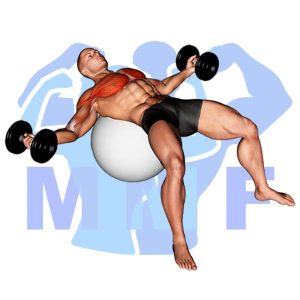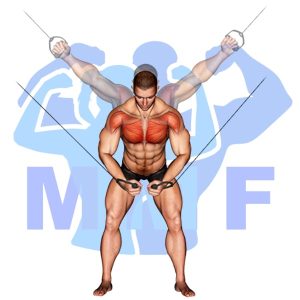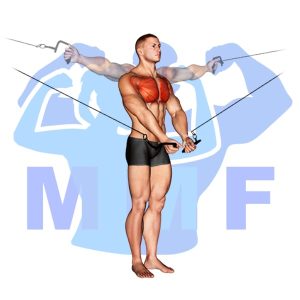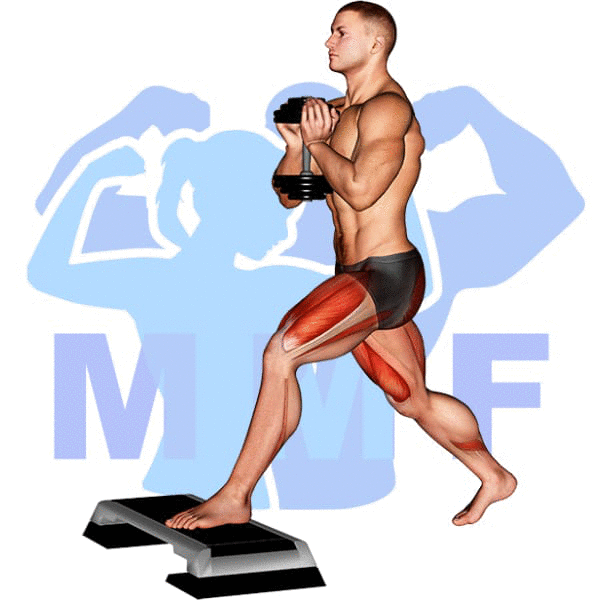Are you tired of doing the same old exercises without seeing any results? Have you hit a plateau in your fitness journey and need a way to switch things up? Look no further than stability ball cable flys. It’s common to feel stuck in our workouts, especially when we stop challenging our muscles in new ways. But with stability ball cable flys, you’re not only adding a new exercise to your routine, but also engaging your core and stabilizer muscles to improve your overall strength. In this post, we’ll break down everything you need to know about stability ball cable flys and how they can take your fitness to the next level.
Stability Ball Cable Flys Summary
- Primary Muscles: Pectoralis Major – Sternal
- Secondary Muscles: Latissimus Dorsi, Levator Scapulae, Pectoralis Major – Clavicular, Pectoralis Minor, and Rhomboids
- Equipment: Cable Machine with Double D-Handle and Stability Ball
- Mechanics Type: Isolated
- Force: Push
- Utility: Auxiliary

Stability Ball Cable Flys Instructions
- Start by attaching two handles to opposite low pulleys and positioning a stability ball between them.
- Grab each handle and sit low on the stability ball, and lay back with your arms extended.
- Now bend your elbows slightly with your palms facing in.
- Next, pull the handles together above your chest while keeping your elbows locked.
- Finally, Let the cable pull your arms back to the side, letting your chest stretch a little.
- Repeat these cable flys for a set of 6-12.
Video Tutorial
Stability Ball Cable Flys Muscles
Target (Agonist)
- Pectoralis Major – Sternal
Synergists
- Latissimus Dorsi
- Levator Scapulae
- Pectoralis Major – Clavicular
- Pectoralis Minor
- Rhomboids
Dynamic Stabilizers
- None
Stabilizers
- Erector Spinae
- Gracilis
- Levator Scapulae
- Pectineus
- Sartorius
- Trapezius – Middle
- Trapezius – Upper
- Vastus Lateralis
Antagonist Stabilizers

Benefits of Stability Ball Cable Flys
Stability Ball Cable Flys are an excellent exercise for targeting the Pectoralis Major – Sternal, which is a major chest muscle. This exercise is a great way to improve strength and stability in the chest area, as it requires the user to maintain balance while performing the exercise. It also helps to develop coordination and proper form while performing the exercise, as it requires a certain degree of balance and control. Additionally, Stability Ball Cable Flys are an effective way to increase range of motion and flexibility in the chest area, as it allows for a greater range of motion than traditional weightlifting exercises. Finally, Stability Ball Cable Flys also help to build muscular endurance, as it can be performed for multiple sets and repetitions.
Tips for Performing Stability Ball Cable Flys
You’ve come at the right location if you want to forge ahead your capability to perform stability ball cable flys. These tips can allow you to fully benefit from this first-class exercise and make the best of its results. You will develop your chest muscles, and even reduce your chances of experiencing an injury. Let’s begin and explore how these tips will benefit you.
- Keep your core tight: Keeping your core tight during the exercise will help you maintain proper form and engage the right muscles to get the most out of your workout. This will help maximize results and reduce the risk of injury.
- Don’t forget to breathe: Remembering to breathe during exercise can help you get more out of your workout, as it helps you stay focused, relaxed, and energized.
- Use a slow, controlled motion: Doing the exercise with a slow, controlled motion will help you target the correct muscles and make sure you’re getting the most out of each rep. This will help you get fit faster and more effectively.
Benefits and Tips Video
Frequent Mistakes To Avoid
Staying away from errors can be the difference between a successful training session and a painful injury when performing stability ball cable flys. Additionally, achieving optimal results from this exercise requires appropriate technique, and avoiding make any typical errors can allow you to perform the exercise better and achieve your desired results. But don’t worry, it’s not at all difficult as it may seem. You can perform the exercise safely and efficiently by avoiding the mistakes to avoid and by executing the correct steps. Thus, it is now your turn to maximize your results from this exercise and enjoy the benefits of a successful workout.
- Not using proper form: Not performing the exercise with the correct form can result in incorrect muscles being worked and can lead to injury.
- Going too heavy: Using too much weight can cause the body to be off balance and increases the risk of injury.
- Not warming up: Not warming up properly before exercising can cause strain on muscles and increase the risk of injury.
Find More Cable Exercises Here
Variations and Complementary Exercises
Stability Ball Cable Flys are a great exercise to target and strengthen the chest, as well as the shoulders and core muscles. However, if you want to mix up your workout routine, there are several variations, complementary, and alternative exercises that can work similar muscles.
Stability Ball Dumbbell Fly

Stability Ball Dumbbell Fly is a great complementary or alternative exercise to Stability Ball Cable Flys. This exercise focuses on working the chest muscles while also engaging the core. It is performed by lying on the stability ball with dumbbells in each hand, palms facing inwards. Keeping your arms slightly bent, lower the dumbbells until they are in line with your chest and then press them back up to the starting position. This exercise can be completed in sets of 8-12 reps, and it is a great way to target the chest muscles while also engaging the core.
Stability Ball Incline Dumbbell Fly

Stability Ball Incline Dumbbell Flys are a great complementary exercise to Stability Ball Cable Flys. This exercise is performed by lying on an incline bench with a dumbbell in each hand and performing a fly motion with the arms outstretched. This exercise helps to strengthen the chest muscles and also works the upper back muscles. It can also be used as an alternative exercise to Stability Ball Cable Flys as it provides an extra challenge to the chest muscles, while still keeping the core engaged and working.
Cable Crossover Flys

Cable Crossover Flys are a great alternative or complementary exercise to Stability Ball Cable Flys. This exercise targets the chest, back, and shoulders. It can be done with a cable machine or resistance bands. To do Cable Crossover Flys, the user stands with feet hip-width apart and a cable handle in each hand. The user then pulls the handles apart in a wide arc, bringing them together at the center. This exercise should be done with slow and controlled movements in order to maximize muscle activation and reduce the risk of injury.
Check Out These Top Cable Exercises
Cable Decline Fly

The Cable Decline Fly is a great complementary or alternative exercise to the Stability Ball Cable Flys. It utilizes the same basic motion but instead of using a stability ball, it is performed on a decline bench. This allows for a greater range of motion, allowing for a deeper chest stretch and higher intensity than the stability ball variation. Additionally, because the cable is pulled from the ground rather than from overhead, it creates a slightly different angle of pull, targeting the chest from a different angle. This exercise can be used to target the lower chest and is great for those looking to add variety and challenge to their chest workout.
Cable Flys

Cable Flys are a great exercise for targeting the muscles of the chest and shoulders. They are a popular alternative to the Stability Ball Cable Flys, as they can be done without the need for a stability ball. This exercise is performed with a cable machine and involves bringing the arms together in front of the body at shoulder height. The main muscles worked during this exercise are the pectoralis major and anterior deltoids. Cable Flys are a great exercise for building strength and increasing muscle definition in the upper body, and they can be used as a complementary or alternative exercise to Stability Ball Cable Flys.
Cable Low Fly

Cable Low Fly is an exercise that can be used as an alternative or complementary to the Stability Ball Cable Flys. The exercise is performed using a cable machine, with the user standing in front of the machine and pulling the cable downwards. The movement will target the chest muscles, with the user having to lower the cable to their waist while keeping their arms straight. This exercise can be used to challenge the same muscles as the Stability Ball Cable Flys, while offering a different angle of resistance. Additionally, Cable Low Flys also engage the core muscles as the user must keep their body stable while performing the exercise.
Find More Chest Exercises Here
Opposing Complementary Exercises
It’s important to work opposing muscle groups when exercising to ensure balanced strength and stability. To complement the exercise Stability Ball Cable Flys, here are some exercises that will help strengthen the opposite muscles:
Dumbbell Palm Rotational Bent Over Row

The Dumbbell Palm Rotational Bent Over Row is an excellent complementary exercise to the Stability Ball Cable Flys. This exercise works the opposing muscle group by targeting the back muscles, including the lats, traps, and rhomboids. By performing this exercise along with the Stability Ball Cable Flys, you will be able to target both your upper back and your chest muscles. The combination of these two exercises will help to build strength and stability in the upper body as well as help to improve posture.
EZ Bar Reverse Grip Bent Over Row

The EZ Bar Reverse Grip Bent Over Row is a great complementary exercise to Stability Ball Cable Flys as it targets the opposing muscle group. It strengthens the back muscles, including the latissimus dorsi, rhomboids, and trapezius, by having you grip the bar with an overhand grip and pull it up toward your chest as you bend your knees and lean forward. This exercise is a great way to build overall upper body strength and balance out your workout routine.
Inverted Rows

Inverted Rows are a great complement to Stability Ball Cable Flys as they use the opposing muscle group. Inverted Rows target the back muscles, specifically the lats, rhomboids, and trapezius muscles. This is in contrast to the chest muscles that are targeted by Stability Ball Cable Flys. This combination of exercises creates a balanced workout that helps to strengthen both the back and chest muscles, providing a well-rounded strength training routine.
Get Stronger and More Stable with Stability Ball Cable Flys!
Adding stability ball cable flys to your workout routine is a great way to improve your strength and stability. These exercises target your chest, shoulders and arms, while using the unstable surface of the stability ball challenges your core muscles as well. The cable allows for a constant tension throughout the entire range of motion, helping to build muscle and increase resistance. Incorporating stability ball cable flys into your workouts can take your fitness to the next level and help you reach your goals.
References: Wikipedia | ExRx.net | PubMed.gov | Comprehensive List of Chest Cable Exercises




